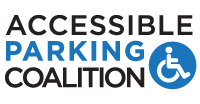Let’s Make Accessible Parking More Accessible: A Practical Guide to Addressing Disabled Placard Abuse and Other Parking Issues for People with Disabilities
This groundbreaking, 24-page publication provides a roadmap for addressing issues related to accessible parking and disabled placard/plate abuse. Topics include statistics that confirm the scope of the problem, deterring fraudulent use of disabled placards/plates, parking design and streetscape issues that interfere with access, misuse of access aisles for van accessible parking spaces, empathetic signage, technological solutions, enforcement issues, citizen activism, and more. The publication includes dozens of ideas from cities, universities, and others, along with practical action items.
Source Credit: Accessible Parking Coalition
View Online
Download — APC Guide: Let’s Make Accessible Parking More Accessible
(PDF | 6mb)
